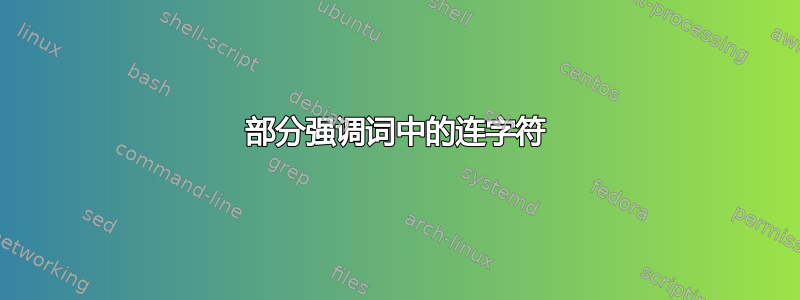
我经常会排版文本,由于特定的语言学惯例,较短的部分单词被强调。据我了解,-tag 的开始/结束\emph被视为单词边界,导致一些正确使用连字符的单词,但是数量太少。
\documentclass[12pt]{article}
%\usepackage[english]{babel}
%\usepackage{polyglossia}
%\setdefaultlanguage{english}
\begin{document}
\parbox{.7cm}{
some hyphenati\emph{o}n
}
\hspace{2cm}\parbox{.7cm}{
some hyphenat\emph{i}on
}
\hspace{2cm}\parbox{.7cm}{
some h\emph{y}phenation
}
\hspace{2cm}\parbox{.7cm}{
some h\emph{y}phe\emph{n}ation
}
\end{document}
我正在寻找一种方法,让 LaTeX 在确定连字符时忽略强调并将单词视为整体。
答案1
\textit{...}和\emph{...}插入斜体校正(TeX 术语中,一种“隐式字距”,阻止连字符),但不会{\itshape ...}。因此,\itshape不会,本身,阻止连字。
如果您可以使用 LuaLaTeX 并且愿意使用\itshape它来提供强调(并且在此过程中,接受缺乏对单词内强调材料的斜体校正),那么您最终可以将这些单词用连字符连接起来。
MWE——观察在每个实例中“找到”所有允许的连字点:
% !TEX TS-program = lualatex
\documentclass[12pt]{article}
\usepackage{showhyphens} % a LuaLaTeX-only package
\hyphenation{hy-phen-a-tion} % indicate all 3 permissible hyphenation points
\setlength\parindent{0pt}
\setlength\textwidth{0.1mm}
\begin{document}
\obeylines
hyphenati{\itshape o}n
hyphenat{\itshape i}on
h{\itshape y}phenation
h{\itshape y}phe{\itshape n}ation
\end{document}



